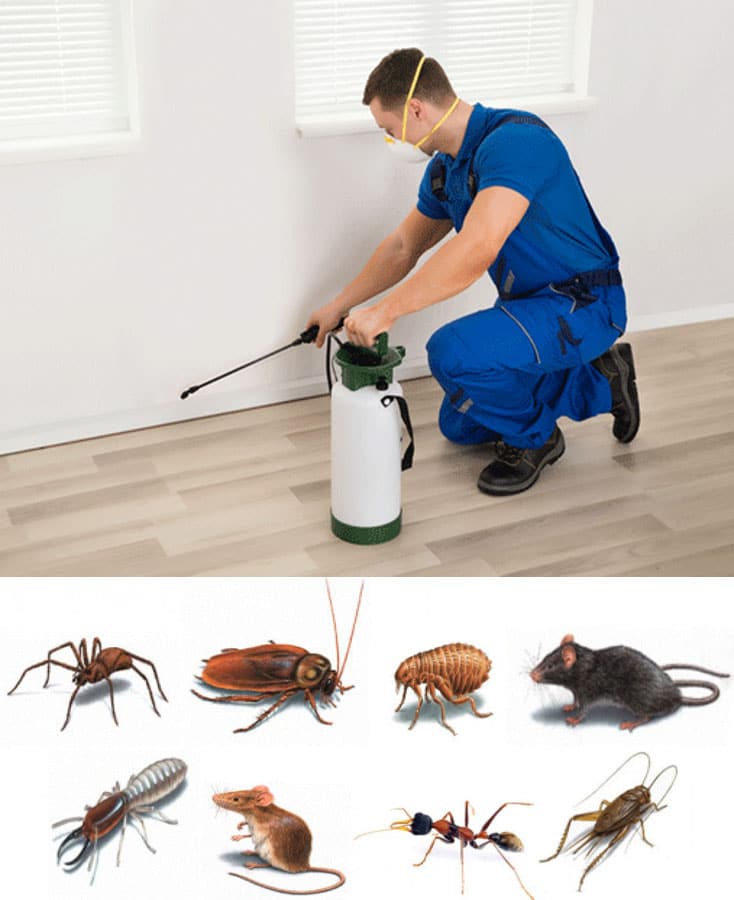A1 Charlotte Pest Control Companies - Your Local Pest Experts
A1 Charlotte Pest Control Companies - Your Local Pest Experts
Blog Article
Bed Pest Treatment Break Down: Contrasting Chemical Vs. Non-Chemical Solutions
In the realm of bug control, especially when handling the persistent issue of bed insects, the selection in between chemical and non-chemical therapy services can be a critical one. Both strategies offer distinct benefits and downsides, influencing aspects such as performance, security considerations, and overall expense. By checking out the nuanced information of each approach, a more clear understanding of which course to pursue in dealing with a bed insect problem can be achieved.
Performance of Chemical Therapies
Chemical therapies for bed bug infestations have actually been extensively acknowledged for their powerful and rapid effectiveness in getting rid of these insects. When considering the efficiency of chemical treatments, it is vital to recognize that they can supply a comprehensive and fast option to a bed insect problem. Professional pest control operators typically depend on insecticides to target bed bugs at different stages of their life process, consisting of eggs, fairies, and grownups. These chemicals usually function by interrupting the bed bugs' nervous system, resulting in paralysis and ultimate fatality.
In addition, chemical therapies have the advantage of supplying recurring impacts, suggesting that they can remain to get rid of bed insects also after the initial application. This recurring action is especially advantageous in combating any possible re-infestations. Additionally, the quick activity of chemical therapies can bring relief to people facing serious bed insect problems, permitting them to restore control of their space rapidly.
Safety And Security Worries With Chemical Solutions
One important element that calls for cautious factor to consider when making use of chemical services for bed insect therapy is making certain the security of passengers and the environment. Direct exposure to particular chemicals utilized in bed pest treatments can lead to respiratory system issues, skin inflammation, or other adverse reactions, especially in people with pre-existing problems or sensitivities.
Furthermore, the environmental impact of chemical services is another considerable consideration. Some chemicals made use of in bed insect therapies may be dangerous to useful pests, wildlife, and ecological communities if they leach right into the dirt or water systems. It is vital to utilize chemical treatments judiciously, complying with safety and security guidelines, and thinking about less toxic options to alleviate these risks and make sure the efficient and safe monitoring of bed bug problems.
Advantages of Non-Chemical Techniques
Considering the prospective safety problems and environmental effect connected with chemical services for bed insect treatment, exploring non-chemical methods presents a promising alternative with numerous unique advantages. Non-chemical treatments are environmentally pleasant, as they do not add to air or water pollution, making them a lasting choice for insect control.
In addition, non-chemical solutions can be reliable in targeting bed pests, consisting of hard-to-reach More Info locations where chemical treatments might not pass through. Approaches such as heat treatment, vacuuming, heavy steam cleaning, and mattress coverings give comprehensive obliteration without making use of harmful chemicals. Moreover, non-chemical approaches can be less turbulent, requiring marginal prep work and permitting quicker reentry right into dealt with areas. In general, selecting non-chemical bed pest therapy techniques not only prioritizes safety and ecological defense yet also ensures extensive and reliable insect control.
Limitations of Non-Chemical Treatments

Furthermore, non-chemical therapies often need several applications to achieve successful eradication. This can be taxing and may not constantly ensure total removal of all bed pests and their eggs, specifically in hard-to-reach or covert places.
Furthermore, the success of non-chemical treatments heavily depends on correct execution and thoroughness, which can be testing for people without professional competence. Insufficient application of non-chemical methods might lead to insufficient obliteration, leading to relentless problems and the demand for added therapies.
Therefore, while non-chemical treatments have their benefits, it is important to recognize these restrictions and consider them when identifying one of the most reliable approach for taking care of bed pest invasions.
Expense Contrast: Chemical Vs. Non-Chemical Options
Given the constraints related to non-chemical therapies, an important facet to examine in the context of bed insect administration is the expense contrast between chemical and non-chemical choices. Chemical treatments usually involve the application of pesticides by experts, which can range from $250 to $900 per space, relying on the extent of the invasion and the size of the area to be treated. On the other hand, non-chemical treatments like warmth therapy or steam can be a lot more pricey, with costs varying from $1,000 to $6,000 pest remediation for an entire home. While the first price of chemical therapies may appear lower, numerous therapies might be called for to totally eliminate the problem, potentially increasing the total expense. On the other hand, non-chemical alternatives may provide an extra environment-friendly and sustainable option, although they can be cost-prohibitive for some individuals. Ultimately, when considering the price of bed insect treatment choices, it is very important to weigh the upfront costs versus the effectiveness and lasting sustainability of the selected method.
Final Thought

Considering the possible safety issues and ecological influence associated with chemical options for bed insect treatment, discovering non-chemical techniques presents an appealing choice with several distinctive benefits.Given the constraints connected with non-chemical therapies, an essential aspect to examine in the context of bed insect management is the price comparison in between chemical and non-chemical options. In comparison, non-chemical treatments like warmth treatment or vapor can be extra pricey, with expenses ranging from $1,000 to $6,000 for a whole home. While the first cost of chemical treatments might seem reduced, multiple treatments may be required to completely remove the infestation, possibly increasing the total price.In verdict, when comparing chemical abc pest control and non-chemical bed insect treatment choices, it is crucial to think about performance, safety and security, advantages, restrictions, and cost.
Report this page